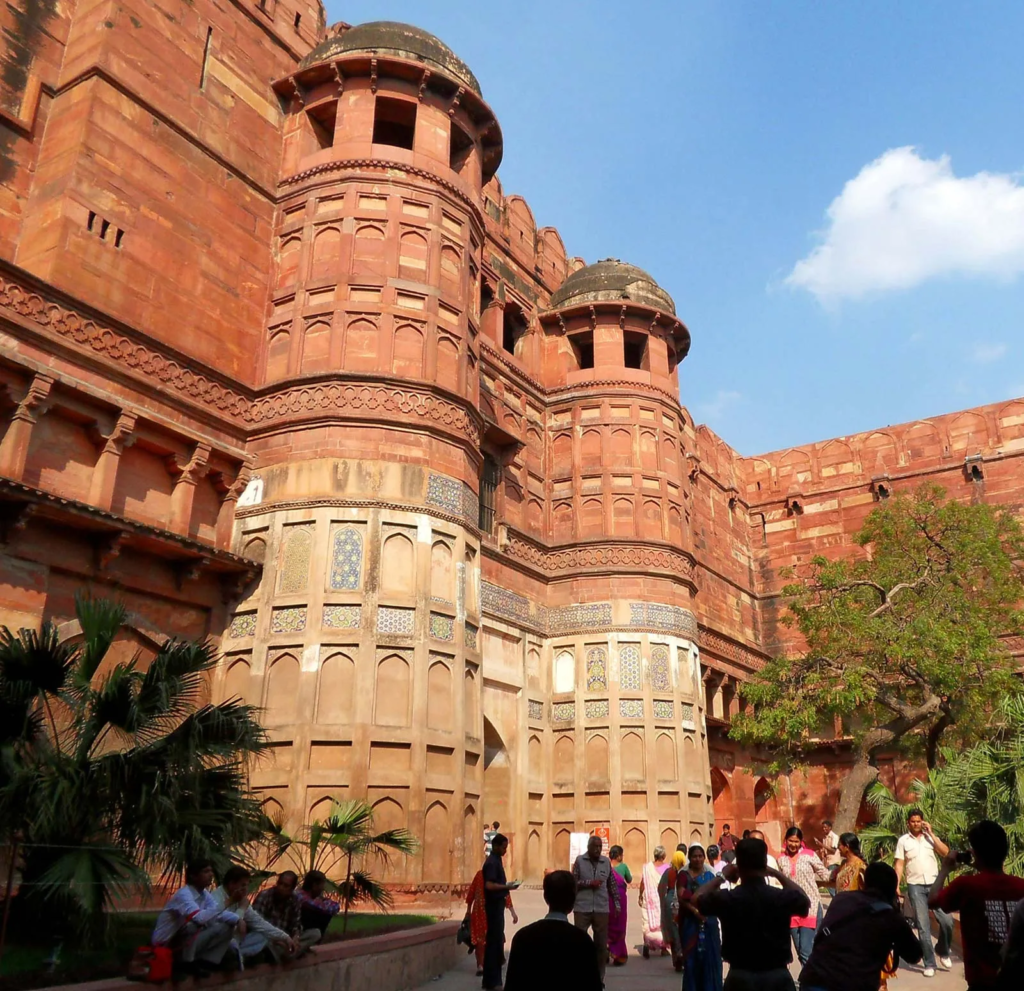Nestled in the heart of India, Agra is a city that beckons travelers with its rich history and captivating architecture. Known primarily as the home of the majestic Taj Mahal, Agra is a treasure trove of cultural experiences, culinary delights, and vibrant local life. It was the capital of Agra (later North-Western) province from 1833 to 1868 and was one of the main centres of the Indian Mutiny (1857–58). Agra is best known for the Taj Mahal (17th century), designated a UNESCO World Heritage site in 1983.

How to reach to Agra?
You may reach Agra via air or road or rail. Agra is a city on the banks of the river Yamuna in the northern state of Uttar Pradesh, India. It is 378 kilometers west of the state capital, Lucknow, 206 kilometers south of the national capital New Delhi, 58 kilometers south from Mathura and 125 kilometers north of Gwalior.
Time to visit Agra
The best time to visit Agra is in the winter season between November to March when the weather is perfect for sightseeing. Another good time to visit Agra is between August and October to witness the Taj Mahal at its best. April-June is the summer season in Agra which is scorching hot and not a good time to visit.
best time to visit Agra depends on the season and what you want to do:
- Winter (October–March): The most popular time to visit Agra, with comfortable temperatures between 10°C and 25°C (50°F and 77°F). The Taj Mahal is often shrouded in a misty haze in the mornings, making it a great time to visit.
- Summer (April–June): Temperatures can reach up to 45°C (113°F), making outdoor activities challenging. However, early mornings and late evenings are better times to visit.
- Monsoon (July–September): Moderate to heavy rainfall can make sightseeing difficult, but the Taj Mahal looks unique surrounded by lush greenery. Temperatures are moderate, ranging from 22°C to 30°C (72°F to 86°F).
- Peak season: The winter months are the peak tourist season, so expect some crowds.
The Taj Mahal: A Love Story in Marble
No visit to Agra would be complete without stopping at the Taj Mahal. This UNESCO World Heritage site, built by Mughal Emperor Shah Jahan in memory of his beloved wife Mumtaz Mahal, is more than just a building; it’s a symbol of eternal love. As you approach this grand marble mausoleum, take a moment to bask in its beauty, especially as the sun rises or sets, casting golden hues across its flawless façade.

Tip: To beat the crowds, arrive early in the morning when the gates open. You’ll have the chance for a serene stroll through the gardens before the influx of visitors.
The Agra Fort: A Fortified Splendor
A mere 2.5 kilometers from the Taj Mahal lies the Agra Fort, another UNESCO World Heritage Site that ignites the imagination with tales of Mughal history. Constructed in red sandstone, this formidable fort served as the main residence of emperors for generations. Wander through its stunning courtyards and opulent palaces such as the Jahangir Mahal and the Khas Mahal.

Don’t miss the view of the Taj Mahal from the fort’s ramparts—it’s a perspective you won’t find in many post cards.
The Local Delicacies: A Taste of Tradition
After a day filled with sights, it’s time to indulge your taste buds. Agra is famed for its delicious local cuisine. Make sure to sample the iconic Petha, a translucent candy made from ash gourd syrup, which comes in various flavors and varieties. Pair it with a plate of Mughlai cuisine, rich in spices and flavors—Biryani and Kebabs are a must-try!
For a true local experience, visit a street vendor for some Chaat—this tangy, flavorful snack is sure to add a zing to your culinary adventure.
Cultural Experiences: Vivid Markets and Artistry
After satiating your hunger, take a stroll through the bustling bazaars of Agra. The vibrant markets, such as Sadar Bazaar and Kinari Bazaar, are overflowing with silk, leather goods, and intricate handicrafts. They are perfect places to hunt for souvenirs, gifts, and mementos.

Moreover, Agra is known for its skilled artisans who craft exquisite marble inlay work, reminiscent of the Taj Mahal’s craftsmanship. Consider visiting a local workshop to witness these artisans at work, where you may even purchase a unique piece of art to take home.
A City of Wonders
Agra is a city where the past and present coexist beautifully. Its architectural wonders tell stories of a bygone era while its vibrant streets pulse with modern life. Whether you’re captivated by history, indulging in local cuisine, or admiring art, Agra is a dazzling gateway into the heart of Indian culture.
For more about careers in Tourism, visit on http://www.icareerkick-mgs.in
accounts marketplace account catalog
account market account exchange service
account marketplace gaming account marketplace
website for selling accounts marketplace for ready-made accounts
secure account sales marketplace for ready-made accounts
account selling service https://social-accounts.org/
marketplace for ready-made accounts buy accounts
account catalog account store
marketplace for ready-made accounts secure account purchasing platform
account buying platform account exchange
guaranteed accounts account buying service
accounts marketplace buy account
account acquisition buy account
account trading platform account exchange
marketplace for ready-made accounts sale-social-accounts.org
buy pre-made account account exchange
website for selling accounts https://accounts-store.org/
buy pre-made account accounts marketplace
account trading service online account store
account market https://top-social-accounts.org/
account exchange service https://accounts-offer.org
accounts for sale https://accounts-marketplace.xyz
purchase ready-made accounts https://buy-best-accounts.org
profitable account sales https://social-accounts-marketplaces.live/
account buying service https://accounts-marketplace.live
database of accounts for sale https://social-accounts-marketplace.xyz
guaranteed accounts buy-accounts.space
account purchase buy-accounts-shop.pro
account trading platform https://buy-accounts.live
account marketplace https://social-accounts-marketplace.live
social media account marketplace https://accounts-marketplace.online
database of accounts for sale https://accounts-marketplace-best.pro
маркетплейс аккаунтов соцсетей https://akkaunty-na-prodazhu.pro
маркетплейс аккаунтов https://rynok-akkauntov.top
продать аккаунт https://kupit-akkaunt.xyz
маркетплейс аккаунтов соцсетей https://akkaunt-magazin.online
маркетплейс аккаунтов https://akkaunty-market.live/
купить аккаунт магазины аккаунтов
продажа аккаунтов akkaunty-optom.live
маркетплейс аккаунтов https://online-akkaunty-magazin.xyz/
маркетплейс аккаунтов akkaunty-dlya-prodazhi.pro
маркетплейс аккаунтов https://kupit-akkaunt.online
buy facebook accounts cheap https://buy-adsaccounts.work
cheap facebook account https://buy-ad-accounts.click
buy facebook accounts buying facebook accounts
buy aged fb account https://buy-ads-account.click/
facebook account sale facebook ad account for sale
cheap facebook accounts https://buy-ads-account.work/
cheap facebook account buy aged facebook ads account
facebook accounts for sale https://buy-ad-account.click/
buy facebook ads accounts facebook ad account for sale
buy google ad account https://buy-ads-account.top
old google ads account for sale https://buy-ads-accounts.click
buy google ads threshold account https://ads-account-for-sale.top
buy google ads threshold accounts https://ads-account-buy.work
buy google ads verified account buy account google ads
buy adwords account https://buy-account-ads.work
buy google ads account https://buy-ads-agency-account.top
google ads account seller https://sell-ads-account.click
google ads account buy https://ads-agency-account-buy.click
Your point of view caught my eye and was very interesting. Thanks. I have a question for you.
buy bm facebook https://buy-business-manager.org/
buy aged google ads accounts https://buy-verified-ads-account.work
buy verified bm facebook buy facebook ads accounts and business managers
buy verified facebook business manager account buy-business-manager-acc.org
facebook business manager account buy buy-verified-business-manager-account.org
buy facebook bm account https://buy-verified-business-manager.org
buy business manager facebook https://business-manager-for-sale.org/
facebook bm buy https://buy-business-manager-verified.org
buy facebook business manager https://buy-bm.org/
buy fb bm https://verified-business-manager-for-sale.org/
buy facebook business account https://buy-business-manager-accounts.org
buy tiktok ads account https://buy-tiktok-ads-account.org
tiktok agency account for sale https://tiktok-ads-account-buy.org
tiktok agency account for sale tiktok ads account buy
buy tiktok ads https://tiktok-agency-account-for-sale.org
tiktok agency account for sale https://buy-tiktok-ad-account.org
tiktok ads agency account https://tiktok-ads-agency-account.org
buy tiktok business account https://buy-tiktok-business-account.org
tiktok ads account for sale https://buy-tiktok-ads.org
888starz честные игры https://1stones.ru/wp-content/pgs/888starz-official-site-aviator.html